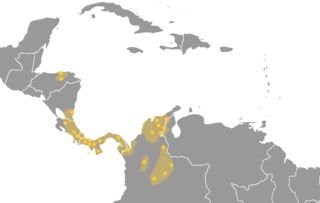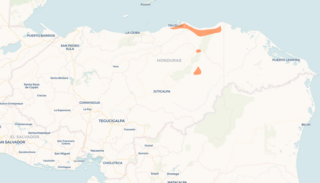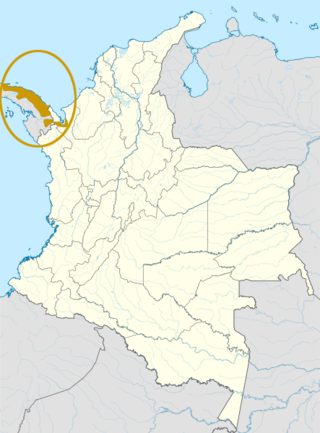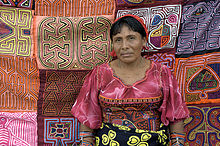H, or h, is the eighth letter of the Latin alphabet, used in the modern English alphabet, including the alphabets of other western European languages and others worldwide. Its name in English is aitch, or regionally haitch.

Guna Yala, formerly known as San Blas, is a comarca indígena in northeast Panama. Guna Yala is home to the indigenous people known as the Gunas. Its capital is Gaigirgordub. It is bounded on the north by the Caribbean Sea, on the south by the Darién Province and Emberá-Wounaan, on the east by Colombia, and on the west by the province of Colón.

The Chibchan languages make up a language family indigenous to the Isthmo-Colombian Area, which extends from eastern Honduras to northern Colombia and includes populations of these countries as well as Nicaragua, Costa Rica, and Panama. The name is derived from the name of an extinct language called Chibcha or Muysccubun, once spoken by the people who lived on the Altiplano Cundiboyacense of which the city of Bogotá was the southern capital at the time of the Spanish Conquista. However, genetic and linguistic data now indicate that the original heart of Chibchan languages and Chibchan-speaking peoples might not have been in Colombia, but in the area of the Costa Rica-Panama border, where the greatest variety of Chibchan languages has been identified.
In phonetics, palatalization or palatization is a way of pronouncing a consonant in which part of the tongue is moved close to the hard palate. Consonants pronounced this way are said to be palatalized and are transcribed in the International Phonetic Alphabet by affixing the letter ⟨ʲ⟩ to the base consonant. Palatalization cannot minimally distinguish words in most dialects of English, but it may do so in languages such as Russian, Japanese, Norwegian (dialects), Võro, Irish and Kashmiri.
Ll/ll is a digraph that occurs in several languages.
A phonemic orthography is an orthography in which the graphemes correspond to the language's phonemes. Natural languages rarely have perfectly phonemic orthographies; a high degree of grapheme–phoneme correspondence can be expected in orthographies based on alphabetic writing systems, but they differ in how complete this correspondence is. English orthography, for example, is alphabetic but highly nonphonemic; it was once mostly phonemic during the Middle English stage, when the modern spellings originated, but spoken English changed rapidly while the orthography was much more stable, resulting in the modern nonphonemic situation. On the contrary the Albanian, Serbian/Croatian/Bosnian/Montenegrin, Romanian, Italian, Turkish, Spanish, Finnish, Czech, Latvian, Esperanto, Korean and Swahili orthographic systems come much closer to being consistent phonemic representations.

A digraph or digram is a pair of characters used in the orthography of a language to write either a single phoneme, or a sequence of phonemes that does not correspond to the normal values of the two characters combined.

The Guna are an indigenous people of Panama and Colombia. Guna people live in three politically autonomous comarcas or autonomous reservations in Panama, and in a few small villages in Colombia. There are also communities of Guna people in Panama City, Colón, and other cities. Most Guna live on small islands off the coast of the comarca of Guna Yala known as the San Blas Islands. The other two Guna comarcas in Panama are Kuna de Madugandí and Kuna de Wargandí. They are Guna-speaking people who once occupied the central region of what is now Panama and the neighboring San Blas Islands and still survive in marginal areas.

The Choctaw language, spoken by the Choctaw, an Indigenous people of the Southeastern Woodlands, USA, is a member of the Muskogean language family. Chickasaw is a separate but closely related language to Choctaw.

The Mola or Molas is a hand-made textile that forms part of the traditional women's clothing of the indigenous Guna people from Panamá. Their clothing includes a patterned wrapped skirt (saburet), a red and yellow headscarf (musue), arm and leg beads (wini), a gold nose ring (olasu) and earrings in addition to the mola blouse (dulemor). Two groups, Choco and Cuna lived side by side without intermarriage and without adopting a similar culture. In Dulegaya, the Guna's native language, "mola" means "shirt" or "clothing". The mola originated with the tradition of Guna women painting their bodies with geometric designs, using available natural colors; at a certain point, after the arrival of the Spanish, these same designs were woven in cotton, and later still, sewn using cloth "acquired by trade from the ships that came to barter for coconuts during the 19th century".
Czech orthography is a system of rules for proper formal writing (orthography) in Czech. The earliest form of separate Latin script specifically designed to suit Czech was devised by Czech theologian and church reformist Jan Hus, the namesake of the Hussite movement, in one of his seminal works, De orthographia bohemica.
This article discusses the phonological system of the Czech language.
Unlike many languages, Icelandic has only very minor dialectal differences in sounds. The language has both monophthongs and diphthongs, and many consonants can be voiced or unvoiced.

The Nukak language is a language of uncertain classification, perhaps part of the macrofamily Puinave-Maku. It is very closely related to Kakwa.

Pech or Pesh is a Chibchan language spoken in Honduras. It was formerly known as Paya, and continues to be referred to in this manner by several sources, though there are negative connotations associated with this term. It has also been referred to as Seco. There are 300 speakers according to Yasugi (2007). It is spoken near the north-central coast of Honduras, in the Dulce Nombre de Culmí municipality of Olancho Department.

Northern Emberá, also known as West Embera and Cholo, is the largest Embera language. It is spoken largely in Colombia, but is also the principal language of the Darién Gap in Panama.The Emberá language is divided into two branches: Northern and Southern. Two prominent Northern groups are Emberá Darien and Catío. The Catío language is spoken by 10,000 - 20,000 people, whose literacy rate is at 1%. The Darien Emberá language is spoken by 9,000-10,000 people.

The Emberá, also known in the historical literature as the Chocó or Katío Indians are an indigenous people of Panama and Colombia. In the Emberá language, the word ẽberá can be used to mean person, man, or indigenous person, depending on the context in which it is used. There are approximately 33,000 people living in Panama and 50,000 in Colombia who identify as Emberá.

The Colombia–Panama border is the 339-kilometer-long (211 mi) international boundary between Colombia and Panama. It also splits the Darién Gap, a break across the South American and North American continents. This large watershed, forest, and mountainous area is in the north-western portion of Colombia's Chocó Department and south-eastern portion of Panama's Darién Province.

The San Blas Rebellion, Guna Revolution or Revolution of Tule was an uprising by the Kuna, to declare independence, in the San Blas Islands, in February 1925.
Narvagandub Dummad is an island off the northeast coast of Panama. The Spanish colonizers called this island, Naranjos Grandes or Big Orange Trees. The island is part of the chain of islands named San Blas Islands, which stretches from the east of the Panama Canal up to the border of Colombia. The archipelago is inhabited by the Guna people, a Native American ethnic group that resides in border areas of Panama and northern Colombia. Their language is part of the Chibchan language family













